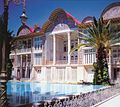Eram Garden (original) (raw)
From Wikipedia, the free encyclopedia
Persian garden in Shiraz, Iran
Bagh-e Eram
| UNESCO World Heritage Site | |
|---|---|
 |
|
| Location | Shiraz, Fars province, Iran |
| Part of | The Persian Garden |
| Reference | 1372-002 |
| Inscription | 2011 (35th Session) |
| Area | 12.7 ha (1,370,000 sq ft) |
| Buffer zone | 70.5 ha (7,590,000 sq ft) |
| Coordinates | 29°38′09″N 52°31′31″E / 29.63583°N 52.52528°E / 29.63583; 52.52528 |
  Location of Eram Garden in Iran Location of Eram Garden in Iran |
Eram Garden (Persian: باغ ارم, Bāgh-e Eram) is a historic Persian garden in Shiraz, Iran. The garden, and the building within it, are located at the northern shore of the Khoshk River in the Fars province.
The origins of the garden may go back to the 12th century, during the Seljuk era, when a garden later called Bagh-e Shah probably existed on this site up to the 18th century.[1][2] This may have influenced the overall layout of the current garden.[1]
The current garden and its pavilions were designed and built in the 19th century, during the Qajar era.[2] The garden was established in 1824[3][4] by Muhammad Qoli Khan Ilkhani, the chief of the Qashqa'i tribe.[3][1] At this time, it included a three-story residential pavilion with a front porch supported by two columns.[3] The estate was later sold to Nasir ol-Molk,[3] who commissioned the architect Muhammad Hasan (the same architect who worked on the Nasir-ol-Molk Mosque) to rebuild the pavilion in its current form between 1875 and 1897.[3][5]
Today, Eram Garden is part of the Shiraz Botanical Garden[2] of Shiraz University. It is open to the public as a historic landscape garden. They are a World Heritage Site and protected by Iran's Cultural Heritage Organization.

Qavam House in Eram Garden
Wide view of the building
Aerial view of the building
Ornamental pool of the Eram Garden
Ornamental pool and date palm at Eram Garden- Persian gardens
- Iranian architecture
- Qavam House
- ^ a b c Hobhouse, Penelope (2004). The Gardens of Persia. Kales Press. pp. 126–129. ISBN 978-0-9670076-6-3.
- ^ a b c Don, Monty; Moore, Derry (2018). "Bagh-e Eram". Paradise Gardens: the world's most beautiful Islamic gardens. John Murray Press. ISBN 978-1-4736-6650-4.
- ^ a b c d e Grigor, Talinn (2021). The Persian Revival: The Imperialism of the Copy in Iranian and Parsi Architecture. Penn State Press. pp. 175–176. ISBN 978-0-271-08968-3.
- ^ Ruggles, D. Fairchild (2008). Islamic Gardens and Landscapes. University of Pennsylvania Press. p. 191. ISBN 9780812207286.
- ^ Curatola, Giovanni; Scarcia, Gianroberto (2007) [2004]. The Art and Architecture of Persia. Translated by Shore, Marguerite. Abbeville Press. p. 238. ISBN 978-0-7892-0920-7.
